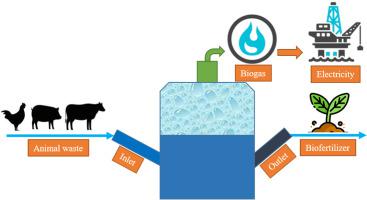Journal of Environmental Chemical Engineering ( IF 7.4 ) Pub Date : 2021-05-13 , DOI: 10.1016/j.jece.2021.105657 M. Mofijur , I.M. Rizwanul Fattah , P. Senthil Kumar , Sk. Yasir Arafat Siddiki , S. M. Ashrafur Rahman , S.F. Ahmed , Hwai Chyuan Ong , Su Shiung Lam , Irfan Anjum Badruddin , T.M. Yunus Khan , T.M.I. Mahlia

|
The farm animal and meat processing industry generate waste, including manure, fat, blood, sludge, bones, and wastewater, which create environmental problems worldwide. The effluents generated by this industry are rich in proteins, lipids, fibres, and carbohydrates. All these pollutants have the potential to be used as a resource for energy recovery. The organic matters obtained from the farm animal and meat processing industry are critical sources for biogas production via anaerobic digestion. This process leads to the production of energy-rich biogas, reducing greenhouse gas emissions. This study attempts to determine biogas amount and the energy value produced from the farm animal and meat processing industry in Australia. Australia's livestock population mainly consists of dairy cattle, meat cattle, sheep and lambs, pigs, layers, and meat chickens. Results show a potential biogas amount of 23,874,165 million m3 (Mm3), 215,670 Mm3, 288,228 Mm3, 18,430 Mm3, and 392,284 Mm3 can be obtained from cattle, lamb, sheep, pig, and poultry annually, respectively. The methane generated from slaughterhouse waste and wastewater is estimated to provide 4.52E+14 MJ/yr of heat energy with total electricity generation potential from livestock wastes of 4.4E+13 kWh/yr. About half of the electricity can be generated in Queensland State. Finally, the present study suggests farm animal and meat processing industry effluent as a potential sustainable energy source in Australia.
中文翻译:

通过处理澳大利亚肉类加工业废物而具有生物能源回收潜力
农场动物和肉类加工业产生废物,包括肥料,脂肪,血液,污泥,骨头和废水,这些废物在全世界范围内造成环境问题。该行业产生的废水富含蛋白质,脂质,纤维和碳水化合物。所有这些污染物都有潜力用作能源回收的资源。从农场动物和肉类加工业获得的有机物是通过厌氧消化生产沼气的重要来源。这个过程导致产生能量丰富的沼气,减少了温室气体的排放。这项研究试图确定澳大利亚农场动物和肉类加工业产生的沼气量和能源价值。澳大利亚的牲畜种群主要包括奶牛,肉牛,绵羊和羔羊,猪,蛋鸡,和肉鸡。结果显示潜在沼气量为23,874,165百万m3(毫米3),215670毫米3,288228毫米3,18430毫米3,和392284毫米3可以从牛,羊,绵羊,猪,家禽和每年分别获得。屠宰场废物和废水产生的甲烷估计可提供4.52E + 14 MJ /年的热能,而牲畜废物产生的总发电潜力为4.4E + 13 kWh /年。昆士兰州大约可产生一半的电力。最后,本研究表明,农场动物和肉类加工业的废水是澳大利亚潜在的可持续能源。











































 京公网安备 11010802027423号
京公网安备 11010802027423号